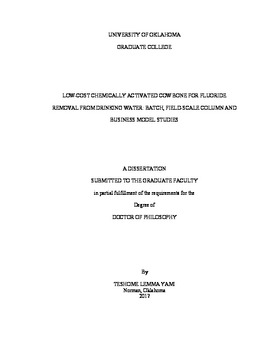| dc.contributor.advisor | Sabatini, David | |
| dc.contributor.author | Yami, Teshome Lemma | |
| dc.date.accessioned | 2017-05-10T15:27:15Z | |
| dc.date.available | 2017-05-10T15:27:15Z | |
| dc.date.issued | 2017-05-13 | |
| dc.identifier.uri | https://hdl.handle.net/11244/50752 | |
| dc.description.abstract | Excess fluoride concentrations in drinking water negatively impact the health of communities living in fluoride affected regions of the world by causing dental and skeletal fluorosis and other severe socio-economic problems. Thermally activated cow bone (bone char) is among the various adsorbents studied for removal of excess fluoride from drinking water. However, the fluoride removal capacity of bone char is low and needs to be enhanced. The goal of this study was to improve the fluoride adsorption capacity of cow bone using chemical activation in place of thermal activation, and to understand the mechanisms responsible for the increased fluoride removal of the chemically activated cow bone (CAB). Cow bone exposed to varying concentrations of chemical activating agents could achieve a four-fold higher fluoride adsorption than bone char both in laboratory batch studies conducted in the University of Oklahoma’s WaTER Center and in field–scale column studies in the Ethiopian Rift Valley. X-ray diffraction analysis conducted on CAB media showed bassanite (CaSO4.0.5H2O) and monetite (CaHPO4) minerals that were not present in bone char; these minerals were thought to be responsible for the high fluoride adsorption capacity of the media.
Monetite and bassanite samples were synthesized and evaluated for their ability to account for the increased fluoride adsorption capacity of the CAB media. A high purity (99.6%) monetite was thus prepared in the laboratory. The monetite had a three-fold higher adsorption capacity than CAB (the fluoride adsorption capacities at an equilibrium fluoride concentration of 1.5 mg/L (Q1.5) were 20.26 mg/g and 6.4 mg/g for monetite and CAB, respectively), thus, validating that monetite can account for the increased capacity of CAB. The EGME specific surface area (SSA) of monetite (Ca/P ratio 1:0.43) is twice that of the CAB media (260 m2/g vs. 134 m2/g) and thus may account for a portion of the three-fold higher capacity of monetite versus CAB. The monetite’s increased capacity can also be partly attributed to the high surface charge (zeta potential) measured on the monetite compared to CAB. In contrast, the bassanite prepared in the laboratory had negligible fluoride removal capacity and thus cannot account for the high adsorption capacity of the CAB media. Therefore, CAB and monetite media have been shown to be superior to bone char for mitigating the negative health impacts of excess fluoride concentrations in drinking water. Finally, this paper addresses how businesses models inform viability of different fluoride treatment technologies for developing countries as well as the pursuit of financial and operational sustainability. In this study, the investment cost of producing fluoride safe water, the annual revenues generated, and the net benefits obtained from different technologies were analyzed. The business model analysis indicated that access to safe water can lead to an average annual cost saving of $67 per person through averted medical costs and productivity losses. The study results validate the use of business models to help evaluate different technologies as a means of pursuing sustainable applications for safe drinking water. | en_US |
| dc.language | en_US | en_US |
| dc.subject | chemical activation, cow bone, fluoride removal, low-cost adsorbent | en_US |
| dc.title | Low-Cost Chemically Activated Cow Bone for Fluoride Removal from Drinking Water: Batch, Field-Scale Column and Business Model Studies | en_US |
| dc.contributor.committeeMember | Butler, Elizabeth | |
| dc.contributor.committeeMember | Busenitz, Lowell | |
| dc.contributor.committeeMember | Spicer, Paul | |
| dc.contributor.committeeMember | Chamberlain, Jim | |
| dc.date.manuscript | 2017-05-02 | |
| dc.thesis.degree | Ph.D. | en_US |
| ou.group | College of Engineering | en_US |
| shareok.nativefileaccess | restricted | en_US |
